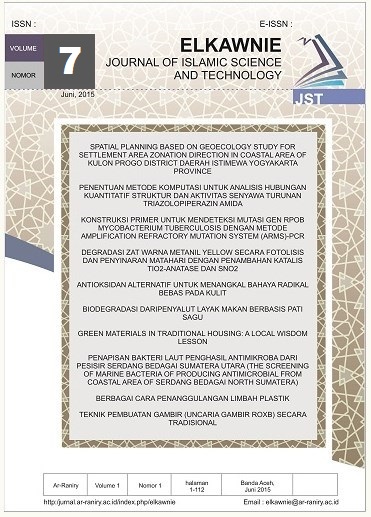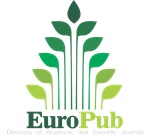The Endophytic Actinobacterial Toxicity Test of Ginger (Zingiber officinale Roscoe) Used The BSLT (Brine Shrimp Lethality Test) Method
DOI:
https://doi.org/10.22373/ekw.v7i1.8027Keywords:
anticancer, endophytic actinobacteria, BSLT, gingerAbstract
Abstract: Cancer is the biggest cause of death in Indonesia. Cancer treatment efforts have been made but it could harm cancer patients. It is necessary to find another alternative from nature as an anticancer. This study aims to see the ability of endophytic actinobacterial isolates from ginger (Zingiber officinale) as an anticancer tested using the BSLT method (Brine Shrimp Lethality Test) by calculating the values of LC50 and LT50. The best value isolates from the BSLT method, then tested using phytochemical ethanol extract. The highest toxicity value was found in AJ2 isolates. LC50 and LT50 values of AJ2 isolates were 309.358 µg/ml and 11.879 hours. Phytochemical results of ethanol extract of AJ2 isolates were detected containing steroids, terpenoids, phenols, tannins, flavonoids, alkaloids, and saponins. AJ2 isolates which derived from ginger endophytic actinobacteria have potential as an anticancer because they have high toxic values that rised rapidly.
Abstrak: Kanker menjadi penyebab kematian terbesar di Indonesia. Upaya pengobatan kanker sudah dilakukan namun memberikan dampak negatif bagi penderita kanker. Perlu dilakukan penemuan alternatif lain berasal dari alam sebagai antikanker. Penelitian ini bertujuan untuk melihat kemampuan isolat aktinobakteri endofit asal jahe (Zingiber officinale) sebagai antikanker. 7 isolat aktinobakteri endofit jahe diuji menggunakan metode BSLT (Brine Shrimp Lethality Test) dengan menghitung nilai LC50 dan LT50. Isolat nilai terbaik dari metode BSLT, selanjutnya diuji menggunakan fitokimia ekstrak etanol. Nilai toksisitas tertinggi terdapat pada isolat AJ2. Nilai LC50 dan LT50 isolat AJ2 adalah 309,358 µg/ml dan 11,879 jam. Hasil fitokimia ekstrak etanol isolat AJ2 terdeteksi mengandung steroid, terpenoid, fenol, tanin, flavonoid, alkaloid dan saponin. Isolat AJ2 yang berasal dari actinobacteria endofit jahe berpotensi sebagai antikanker karena memiliki nilai toksik yang tinggi dalam waktu singkat.
References
Agustina, S., Ruslan, & Wiraningtyas, A. (2016). Drug Phytochemical Screening in Kabupaten Bima. Indonesian E-Journal of Applied Chemistry. 4 (1), 71-76.https://doi.org/10.29122/jbbi.v6i2.3504
Dongdong, C., Ye, T., Mingxuan, X., Xinyuan, W., Ding, L., Xinjuan, Y., Le, Z. (2018), Design, Bioactivity and Structural Activity of 3-Arylpropionate Derivatives as High Efficient Potential Acaricides against Psoroptes Cuniculi. Scientific report. 8 (1797): 1-10. https://doi.org/10.1038/s41598-018-20140-7
Dinesh, R., Srinivasan, V., Sheaja, T.E., Anandraj, M., Srambikkal, H. (2017). Endophytic actinobacteria: Diversity, secondary metabolism and mechanisms to unsilence biosynthetic gene clusters. Critical Reviews in Microbiology. 43(5):546-566. https://doi.org/10.1080/1040841X.2016.1270895.
Chahar, M.K., Sharma, N., Dobhal, M.P.,Joshi, Y.C. (2011). Flavonoids: A Versatile Soure of Anticancer Drugs. Pharmacogn Rev. 5(9): 1-12. https://doi.org/ 10.4103/0973- 7847.79093.
Golinska, P., Wypij, M., Agarkar, G., Rathod, D., Dahm, H., & Rai, M. (2015). Endhophytic Actinobacteria of Medical Plants: Diversity and Bioactivity. Antonic van Leeuwenhoek. 108: 267-289. https://doi.org/10.1007/s10482-015-0502-7
Harborne. (1987). Metode Fitokimia. ITB. Bandung.
Hardiyanti, R., Marpaung, L., Adnyana, I. K., Simanjuntak, P. 2019. Phenolic And Toxicity Test (Brine Shrimp Lethality Test) Extract Methanol Leaves Benalu Duku Hijau (Dendrohtoe Pentandara (L.) Miq) And Red (Scurrula ferruginea (Jack) Danser). Talenta Conference Series: Science & Technology (ST). 2(1): 84-87. https://doi.org/10.32734/st.v2i1.319
Inthe, M. G., Tarman, K., & Safithri, M,. (2014) Fraksinasi Protein Kapang Laut Xylaria psidii KT30 dan Sitotoksisitasnya Terhadap sel Hela. Jurnal Teknologi dan Industri Pangan. 25(1): 39-46. https://doi.org/10.6066/jtip.2014.25.1.39
Kim, Y.P., Tomoda, H., Iilzima, K., Fakuda, T., Matsumoto, A., Takahashi, Y., & Omura, S. (2003). Takanawaenes, Novel Antifungal Antibiotics Produced by Streptomyces sp. K99-5278. I. Taxonomy, Fermentation, Isolation and Biological Properties. 56(5): 488-453.https://doi.org/10.7164/antibiotics.56.448.
Mariana, L., Andayani, Y., & Gunawan, E. R. (2013). Analisa Senyawa Flavonoid Hasil Fraksinasi Ekstrak Diklorometana Daun Keluwih (A. camansi). Chemistry Progress. 6(2): 50-55. https://doi.org/10.35799/cp.6.2.2013.3494
Meyer, B. N., Ferrigni, N. R., Putman, J. E., Jacobsen, L. B., Nichols, D. E., & McLauglin, J. L. (1982). Brine Shrimp: A Convenient General Bioassay for Active Plant Constituents. Journal of Medical Plant Research. 45: 31-34. https://doi.org/10.1055/s-2007-971236
Mirzaei, M., Mirzaei, A. 2013. Comparison of the Artemia salina and Artemia uramiana bioassays for toxicity of 4 Iranian medicinal plants. International Research Journal of Biological Sciences. 2(3): 49-54
Muaja, A. D., Koleangan, H. S. J., & Rutuwene, M. R. J. (2013). Uji Toksisitas dengan Metode BSLT dan Analisis Kandungan Fitokimia Ekstrak Daun Soyogik (Saurauia bracteosa DC) dengan Metode Soxhletasi. Jurnal MIPA Unsrat. 2(2): 115- 118. https://doi.org/10.35799/jm.2.2.2013.3000
Ningdyah, A. W., Alimuddin, A. H., & Jayuska, A. (2015). Uji Toksisitas dengan Metode BSLT (Brine Shrimp Lethality Test) terhadap Hasil Fraksinasi Ekstrak Kulit Buah Tampoi (Baccaurea macrocarpa). Jurnal Kimia Khatulistiwa. 4(1):75-83.
Nurhaifah, D., & Sukesi, T., W. (2015). Efektifitas Air Perasan Kulit Jeruk Manis Sebagai Larvasida Nyamuk Aedes aegypty. Jurnal Kesehatan Masyarakat Nasional. 9(7): 207-213. http://dx.doi.org/10.21109/kesmas.v9i3.566
Oratmangun, S. A., Fatimawati, & Budhi, W. (2004). Uji Toksisitas Ekstrak Tanaman Patah Tulang (Euphorbia tirucalli L.) Terhadap Artemia Salina dengan Metode Brine Shrimp Lethality Test (BSLT) Sebagai Studi Pendahuluan Potensi Antikanker. Jurnal Ilmiah Farmasi. 3(3): 316-324. https://doi.org/10.35799/pha.3.2014.5449
Pangastuti, A., Amin, I. F., Amin, A. Z., Amin, M. 2016. Natural Bioactive Compound from Moringa oleifera Against Cancer Based on in Silico Screening. Jurnal Teknologi. 78(5): 315-318. https://doi.org/ https://doi.org/10.11113/jt.v78.8328
Parbuntari, H, Prestica, Y., Gunawan, R., Nurman, M. N., & Adella, F. (2018). Preliminary Phytochemical Screening (Qualitativ Analysis of Cacao Leaves (Theobroma cacao L.). Eksakta. 19 (2). 10. https://doi.org/24036/eksakta/vol19-iss02/142
Pujiyanto, S. (2012). Kajian Inhibitor α-glukosidase aktinomiset endofit asal brotowali (Tinospora crispa). Disertasi. Sekolah Pascasarjana Institut Pertanian Bogor
Rahayu, S., Fitri, L., Ismail, Y. S. 2019. Short communication: Endophytic actinobacteria isolated from ginger (Zingiber officinale) and its potential as a pancreatic lipase inhibitor and its toxicity. Biodiversitas. 20(5): 1312-1317. https://doi.org/10.13057/biodiv/d200510
Sukandar, D., Hermanto, S., & Lestari, E. (2009). Uji Potensi Aktivitas Antikanker Ekstrak Daun Pandan Wangi (Pandanus amaryllifolius Roxb) dengan metode Brine Shrimp Lethality Test (BSLT). Jurnal Kimia Terapan Indonesia. 11(1):32-38. https://doi.org/10.14203/jkti.v11i1.174
Taechowisan T, Peberdy JF, Lumyang S. 2003. Isolation of endophytic Actinomycetes from selected plant and their antifungal activity. World J Microbiol Biotechnol. 19: 381-385. https://doi.org/ 10.1023/A:1023901107182
Downloads
Published
Issue
Section
License
Proposed Policy for Journals That Offer Open Access Authors who publish with the Elkawnie journal agree to the following terms:
a. Authors retain copyright and grant the journal right of first publication with the work simultaneously licensed under a Creative Commons Attribution License that allows others to share the work with an acknowledgement of the work's authorship and initial publication in this journal.
b. Authors are able to enter into separate, additional contractual arrangements for the non-exclusive distribution of the journal's published version of the work (e.g., post it to an institutional repository or publish it in a book), with an acknowledgement of its initial publication in this journal.
c. Authors are permitted and encouraged to post their work online (e.g., in institutional repositories or on their website) prior to and during the submission process, as it can lead to productive exchanges, as well as earlier and greater citation of published work (see The Effect of Open Access).

























